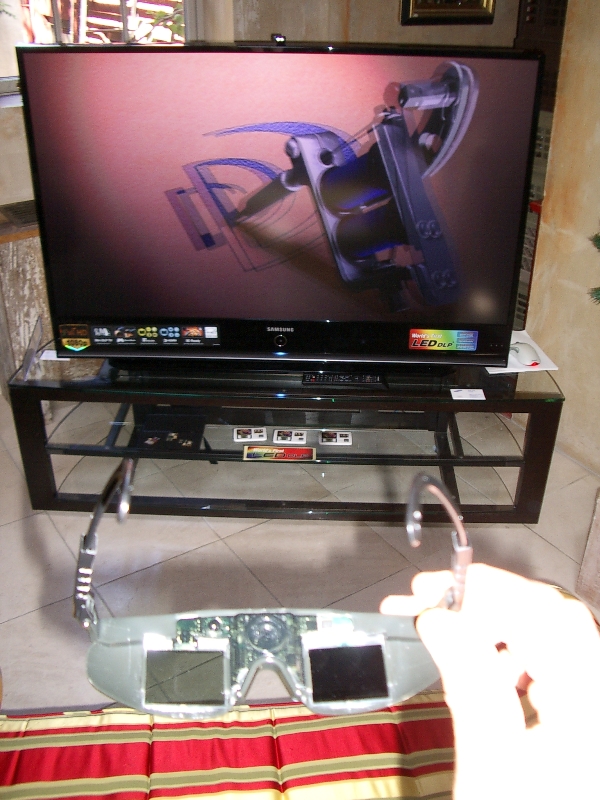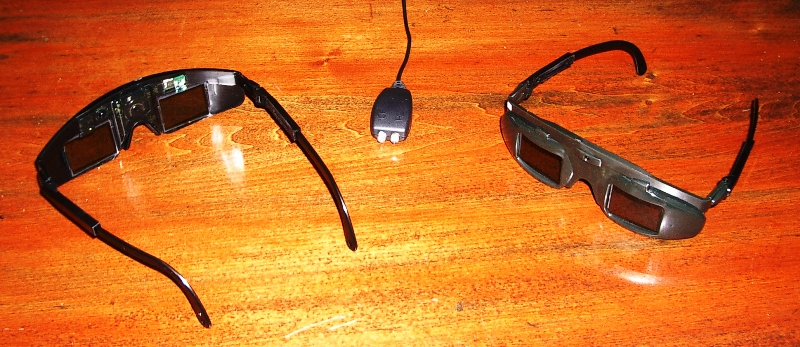You can now buy 3-D glasses that will work with any new Samsung DLP-based rear-projection HDTV.
I’ve been lucky enough to have been in this business long enough to see nearly everything. I even know the fix for the Samsung TV blinking red light, something that has driven many buyers insane in the past. In this case, I used to sell the Vectrex electronic game to the American Audio Clubs in Germany and so was able to play with all the accessories, including the light pen and the color-wheel based 3-D glasses.
The glasses (the first video 3-D device) were traditional alternate-frame/eye synchronization using a spinning color wheel synched to the screen. As the blocked/color/clear disk passed before each eye the corresponding frame was displayed. This is the core tech for half the devices used today, as parallax separation is a difficult task and you don’t need to play with the optics in an alternate-eye configuration.
Samsung’s glasses use LCDs to perform the rapid alternate-eye switching needed. They exploit the rapid switching capability of the DLP chip to create the rapid alternating images. The glasses are steered by an IR emitter on a cable that you place at the top of the screen.
The important difference is that up until this device, the glasses required for parallax splitting had to be physically tethered to the display involved for power and sync. LCDs are now available with very little current draw (especially for strobe on/off apps), and the driver circuitry is now on a single chip. These glasses are tolerable because they are untethered.
They work with every Samsung TV manufactured this model year.

















Man that makes me nostalgic for those cardboard red and blue glasses for the St. Louis channel 11 late show “in living 3D” always followed by the 3 stooges. My personal favorite was “The Creeping Flesh.”
Does it work with the iPhone?
Is it equivalent to the IMAX 3d effect, with the polarized glasses? Or it is it better?
I saw the new Harry Potter movie this weekend, and could have done without the 3d gimmick for the last 20 minutes. It was somewhat cool, but mostly not worth the trade off in distraction, image/color quality loss and potential for headache. Superman Returns was similarly disappointing.
3,
There are three methods most commonly used for 3-D using glasses. Note all require twin viewpoints during filming for the needed parallax separation. (There are computer algorithms some use to derive pseudo-3D, but that is a different issue.)
The first uses red and green lenses to block one eye’s data from another. You just have to use optics to split the red and green colors to the left and right eyes.
The second uses polarization to split the information. The right eye info is displayed with a polarization at right angles to the left eye, polarized lenses in the glasses perform the separation.
The third uses physical blocking of each eye to prevent it from seeing the information required for the other. LCDs swictch quickly enough and the DLP can respond in kind to present the different info to each eye in sequence. The big advantage to this is that it only needs timing, not optics, to perform the trick.
5–So the headlines above are wrong? You need a Samsung TV
AND YOU NEED originally created 3-D material???
Meaning, nothing in 3D is available right now.
—or not?—
It’s even a selling point for Samsung TVs:
This is not new technology, untethered LCD blocking glasses have been in use for years with CrystalEyes. It might be new for the consumer level.
Also, if the technology works the same at the old CrystalEyes, you sort of loose half your refresh rate to view in 3D. So the 120Hz refresh, goes down to 60 for each eye. Which is still very good, but think of what it was some years back, which on top of price, it was not in a mass market.
I watched the recent Harry Potter movie in IMax 3d. Only the last 20 minutes was 3d but even after that short time… ouch the back of my eyeballs hurt.
9,
Eye fatigue is the primary reason I’m not a big fan of 3-D systems. The only one that I felt was adaquate was a twin-display OLED near-eye system.
#10, Alix, Flying west where the light from the setting sun is right through a 3,000 RPM three-blade prop can make you crazy, and that’s a substantial frame rate. I wonder if I could stand the alternating eye trick at even 60 fps for long. Still, it’s some nice tech.
Having come up with this very system myself over 20 years ago, it’s kind of bittersweet to see it finally reach the consumer market; sweet because it proves that it works and at an affordable price point, and bitter because I could get no potential investors to consider it at the time…
Anyway, versus the other systems, there should be no chroma artifacts or diminished res – the only thing you lose here is your brightness, which, obviously, is cut in half.
…as well as the frame rate, but I’m sure they’re using alternate fields and not frames, since dividing the 60Hz field rate by 2 puts us back at standard 30Hz, but using the full 30Hz frame rate alternately would yield an unacceptable 15Hz. So I doubt headaches should be an issue for most ppl.
#12 Having come up with this very system myself over 20 years ago, it’s kind of bittersweet to see it finally reach the consumer market;
A friend of mine had an Amiga 2000, and used to give me endless crap about how much better it was than my Mac…
Anyway, it was late-80’s – and I remember us shopping at a computer store south of Seattle [Federal Way?] which had LCD-shutter glasses for use while tethered to a specific video-card.
I believe it was supposed to work in my buddies Amiga – except he couldn’t afford it on our Navy salary.
He couldn’t afford the Video Toaster he wanted, either…
Man, is Babylon 5 really that old? 🙂
Anybody know “exactly” why virutal reality headsets are not here by now? Another technology that has been on display for years and that is really not much more than stereo glasses?
I played the virutal reality game “Peridactyl” at the Vancouver worlds Fair and thought it wouldn’t be more than 10years before the home computer would give us all these games?
Now, I’d like to fly above the earth in near real time a la Google Earth. Still waiting.
#13 – Mike Voice
“…LCD-shutter glasses for use while tethered to a specific video-card.”
Hmm. Well, wouldn’t surprise me, since I always felt it was a reasonably obvious idea to bypass the drawbacks of those spinning-disc shutters and polarizers… but this, as you say, was on a computer, and I’m sure it was a matter of roll-your-own source material, vector graphics – and pretty slow, too, since LCDs of the time were pretty leisurely in response.
But I never saw any evidence of anyone trying to apply LCD shutters to strereo video until well into the ’90s – JVC announced a system played back from a proprietary capacitive-discharge videodisc that never took off.
One small step for man, one giant leap for 3D pr0n!
I’ve always been interested in 3D stills & video and own a couple proper 3D cameras & a 35mm 3D converter.
One of the most interesting 3D effects I ever came across as a kid, was a film projector, offered in a comic book, that claimed to turn ordinary 2D 8mm & Super-8 films into 3D(!) And it could. Sort of. How would that be possible?
It was a cheat. But it was still real 3D. As I recall, it had two lenses. One lens projected a frame, while another lens was able to project a different frame… maybe 2 frames away.
The stereoscopic parallax came from viewing objects in the frame whose position changed ever-so-slightly to give the brain slightly different views & angles of the object.
So while one eye might view a moving leg in one position, the other eye viewed the same leg in a slightly different position as depicted a few frames earlier. Add in the usual polarizing or red/green filters and there… technically… was your less-than-good stereo. It just worked on moving objects in the frame. Or at least that’s how I thought it worked.
Then there was the stereo that could be created on a single TV screen – one single picture, no glasses. But it too had a less-than-satisfactory result.
Somehow the inventors managed to combine left & right video images consecutively (like the DLP above) – such that when viewed, close images alternately wiggled left & right a lot while distant images wiggled left & right little or not at all. It actually fooled the brain into thinking it was seeing stereo, though obviously not in a natural sort of way.
The inventors claimed they were soon going to be able to remove the “wiggle” effect but I always thought that was stock-investment BS given that was the reason you perceived the stereo.
RBG
Here’s a 3D stereo photo. Let your eyes relax as you look at it so that they are focused on infinity. You will see three images. The one in the middle will be 3D.

#19, Hop, that’s pretty cool, sort of like “Magic Eye” pix but with a real photo. BTW, seems to help if you back off about 4 feet from the monitor to get your eyes relaxed, lock onto the three images, then move slowly back in. Curiously, unlike “Magic Eye”, the effect seems to be the same if you just cross your eyes a bit until you see the three images. Neat!
Alix, any strobe light effect with these on? It seems to me it would exacerbate that problem, and not improve it.
21,
No, the switching is very clean. The image was acxtually very good, although I believe eye fatrigue would make you want to stop after an hour or so. I think it would work even better in a dark room where peripheral distraction is at a minimum.
The other way is to just cross your eyes until a third 3D photo appears in the middle.
RBG
It’s a little tougher on your eyes if you cross them. If you focus on infinity, you can look at lots of these type of photos without straining your eyes.
There is a fourth method for displaying 3D, using circular polarization. One image is displayed with circular polarization. The second image is displayed with no polarization, but is dimmer.
With your bare eyes, you’d see the brighter, circularly polarized image; it “masks” the dim image.
Wear a monocle over one eye, set to block the circularly polarized image, and that eye sees the dim image. (It also adapts, so that both images appear equally bright.) So you see in 3D.
The idea was that people who objected to wearing any kind of glasses could still watch the movie in 2D, without seeing a double image.
This was invented by Edwin Land, but it never caught on. (I still have the monocle he gave me, around somewhere.)